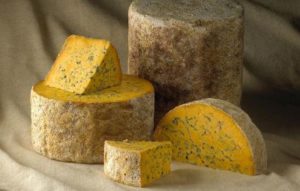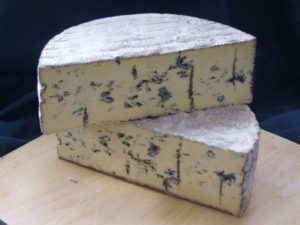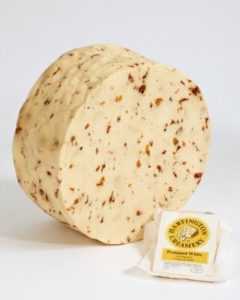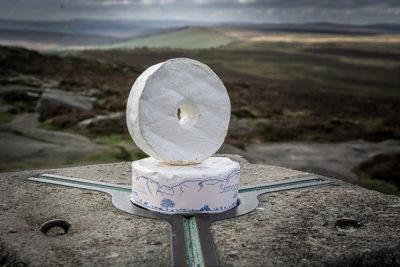
Until recently, Shropshire Blue had never been made in Shropshire. Who knew? Time for a history lesson.
In his 1995 book “The Great Cheeses of Great Britain and Ireland”, Robert Smith writes:
Shropshire Blue is a misnomer as the cheese was first produced in Scotland. Penicillium roqueforte produces the blue veins, and annatto gives a golden-orange colour. Ripened for 10–12 week, when it is said that the cheese has ‘a bit more bite than Stilton’. Makers include Colston Bassett, Cropwell Bishop, Long Clawson, Millway and Tuxford and Tebbutt.
This list of makers is also a list of the Midlands Stilton-producing powerhouses, and today includes Hartington, who make our Shropshire.
In 1982, Patrick Rance wrote a more detailed history of the early years of Shropshire Blue in “The Great British Cheese Book”, in his own distinctive style:
One of the blue cheeses made for some years at Castle Stuart Dairy, Inverness, was sponsored by Adamsons of Short Street, London, who sold it as Shropshire Blue. Andy Williamson, much respected in the Stilton world, went back to Scotland to make the new cheese, a lightly pressed blue with a deep red curd, which found a ready sale throughout the country in good cheese shops. Then orders were refused in spring 1980, with a promise of ‘more later’. For unexplained and unfathomable reasons the North of Scotland Milk Marketing Board had closed the dairy and the ‘more later’ came from Hankelow. Elliot Hulme and his Blue Cheshire cheesemaker Harry Hanlin showed their first public Shropshire Blue at the Nantwich Show in July 1980. They had been helped with advice from Charlie Chisholm, who managed the Castle Stuart Dairy when the cheese was made there.
All the milk for the cheese was unpsteurised, and came from Hankelow pastures. Mr Hulme had to quote EEC regulations against monopolistic restraint of trade to persuade the Milk Marketing Board to let him buy his extra milk for his enterprise from his co-operator.
Mr Hulme told me in September 1980 that first Shropshire Blues from Hankelow has proved a little firmer and deeper red than the cheeses made in Inverness. He has since ceased production, but in 1981 John Adamson and Company got Long Clawson Stilton Dairy interested in this cheese, coming back to the nineteenth-century conception of Stilton Cheshire.
Not much has changed with this tasty, orange coloured, blue cheese since then. Pasteurised milk is now used, as
is using animal rennet, so the cheese is not suitable for veggieburgers.






